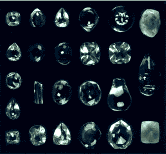
Models of the celebrated large Historical Diamonds Collection,
Glass, England, 1873-93, Department of Mineralogy, UMUT
With the Reference of Crystal Replica of the same
collection, Germany, 2000
|
|
Preface to the exhibition
Between Original and Reproduction
Today we are surrounded by a lot of "copies". Although we use the word "copy" simply, it means not only a precise replica produced as an essence of artistry or reprints like photographs and printed matters but also despised forgeries, reproductions, imitations, representations, models, fakes, counterfeits, shams, and even recent digital images and virtual realities which do not carry substance. Thus, "copy" includes substantial and non-substantial objects which vary widely and extensively in shape and phase. Therefore, it is difficult to define clearly what a copy is.
However, it is certain that "copies" overflow wildly and ceaselessly as one "copy" is then used as a model for another "copy", and inversely an "original" generating a "copy" fades away. The traditional principle which maintains that only an original work of art can be orthodox and its existence is absolutely sacred and a priori is being challenged. Instead, the pragmatic thought that the "copy" is useful enough as a substitute for its original is becoming the trend.
Recognizing such current trends of this age, we discuss how our existence is surrounded by copy phenomenon, that is, things copied, copying them, using copies, and consisting of copies, moreover, things or behaviors that only exist in copies.
As a matter of course, when we question the copy issue, at the same time we question the existing conditions of the concept of what is "original", the opposite of "copy". Furthermore, we will reveal that the traditional original versus copy dualism is fake and fictitious. As the copy is not easy to define, the original also defies easy definition. However, according to our observation, we often find copying at the basis of generative formation. If it is considered like the above, before you conclude that copied things are not original, we suggest that you invert the common sense and affirm that what claims original and is called original is merely the result of "copy".
This exhibition is held in order to open to the public the fruits of our study from the 1999 ~ 2001 seminar of Museo-technology. This seminar's purpose was to experience the planning and implementation of an exhibition and the seminar was attended by more than one hundred undergraduate and graduate students. The students have discussed the planning and the choice of objects, arranged the loans of the objects, organized the exhibition, documented the catalogue, handled publicity, and kept a record of the exhibition for eighteen months. We are proud of the number of the participants in this project, and are trying to evaluate its effectiveness. We would be pleased to have your sincere evaluation and criticism concerning on the contents of this exhibition and its catalogue.
Realization of this exhibition has required the collaboration and support of many scholars, research groups, and institutions in various fields. We are grateful to those who gave us intensive lectures on their specialties in the seminar, both public and private institutions that cooperated with our many kinds of research, the museums and individuals who loaned us their valuable collections, and others involved in this project. We would like to extend our thanks to all the institutions and individuals who contribute in many ways to realize the exhibition "Between Original and Reproduction: the Art of Making Copies--- from Duchamp to DNA".
|
